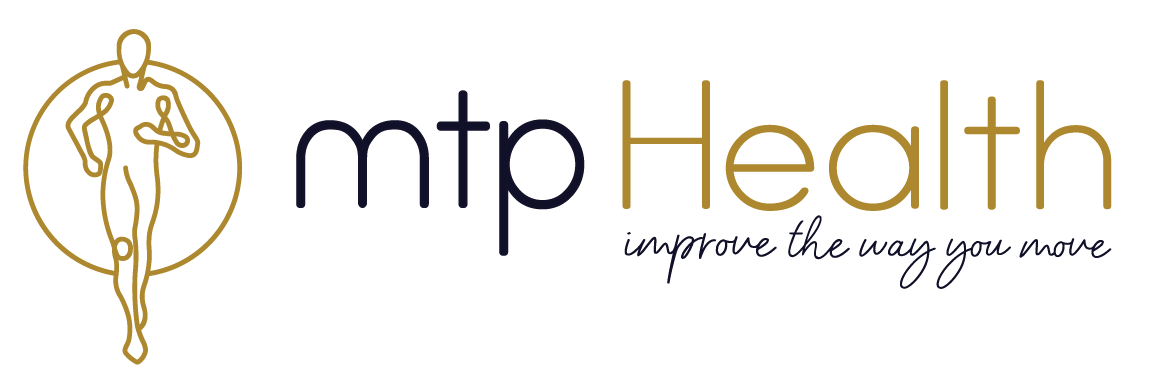The Ultimate Guide to TMJ & Jaw Pain
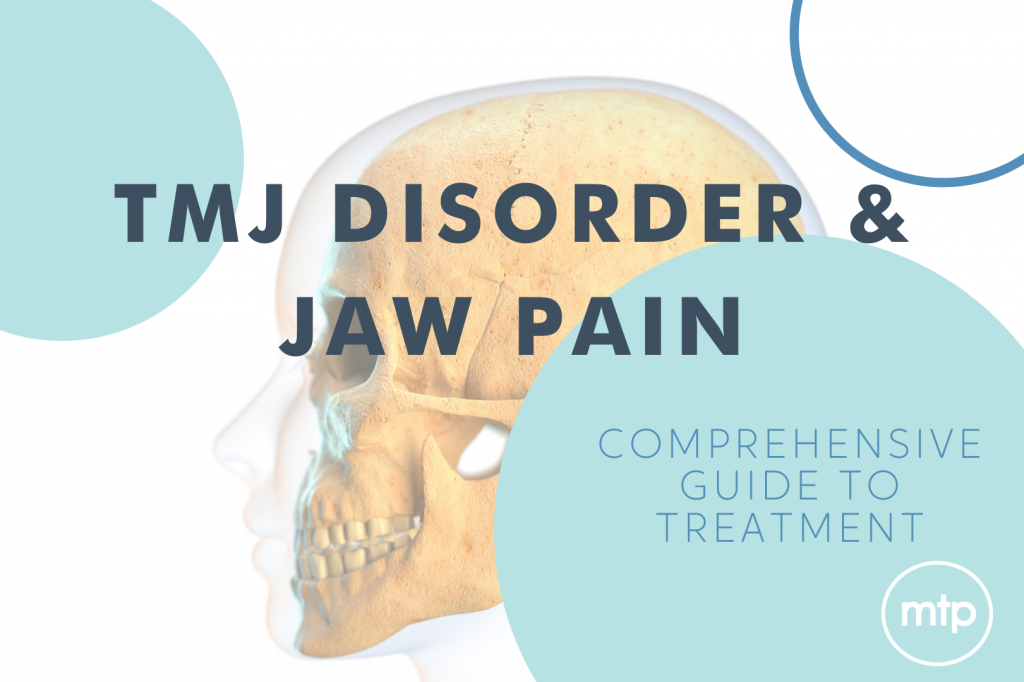
TMJ
Temporomandibular Joint Dysfunction (TMJD) is an issue that affects many people, being caused by a range of different factors and can be quite stubborn to treat.
TMJ Disorder consists of a wide variety of symptoms ranging from pain, clicking, difficulty eating, lockjaw or loss of opening (Trismus), teeth grinding or clenching along with referred symptoms including headaches, earache, tinnitus and vertigo.
The video below gives a nice anatomical summary of the condition and what can cause it and a rough look at some of the treatment options. Our aim with this article is to provide a useful guide that can help you in dealing with all of the factors that contribute to your TMJ pain with our unique approach at MTP Health. We will show you, through the course of this article, how to address not only the symptoms you’re facing but also how to address the likely root cause of your issue.
https://www.youtube.com/watch?v=cB2XKBGWhZ0
Who is likely to be affected by it?
Around 60-70% of the population will suffer from TMJ Disorder at some point in their life. The most common incidences of the condition occur in those between the ages of 20 and 40. This age group is highly susceptible to the condition due to the large psychological component to the condition.
Factors that can contribute to TMJ Disorder include: stress and anxiety, abnormal posture, fibromyalgia and chronic pain. Other structural factors such as dental issues, osteoarthritis, rheumatoid arthritis, hypermobility and trauma can also lead to pain and dysfunction.
What causes it?
In essence, TMJ Dysfunction is a multifactorial issue, with the causes being able to be boiled down to both subjective & objective factors. We will summarise the most common of each below:
Objective
- Structural abnormalities
- Correlation to other pathologies & chronic conditions
- Overweight
Subjective
- Psychological state
- Experience of pain
One of the more popular ways to address TMJ pain & the many subjective factors that go into it is by using the biobehavioural mode pictured below.
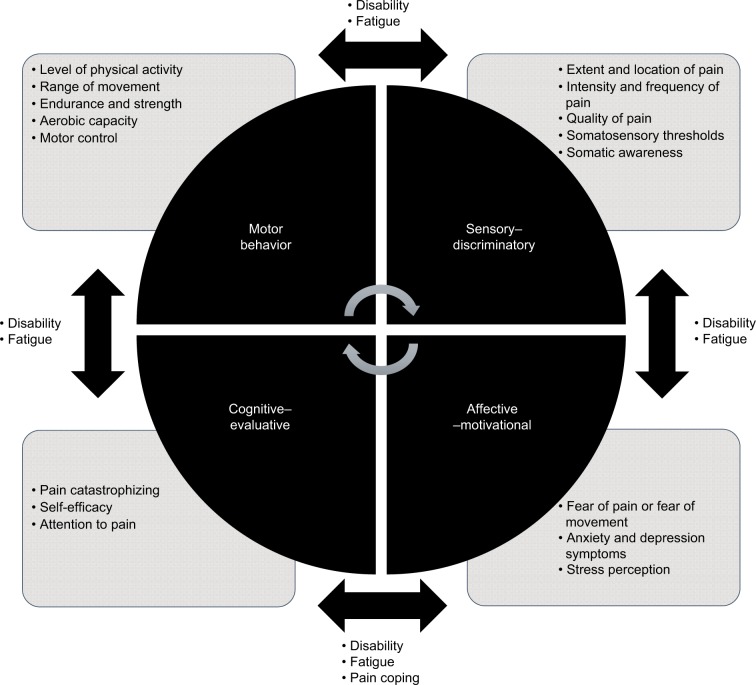
The four dimensions of the biobehavioral model of pain perception and motor behaviour, which help to explain subjective factors related to TMJ [Click Image For Full Paper]
How MTP Treats It
Initial Assessment
Specialist [Primary Assessment]
At MTP Health, we’re acutely aware of the multitude of factors that go into TMJ pain. As such we always strongly recommend that patients undergo a thorough initial screening with a primary care physician & a dentist to properly screen for any structural problems, objective factors & other potential contributing pathologies. TMJ pain can also be related to other pathologies which is why it needs to be full investigated and assessed by a primary care clinician or dentist.
Practitioner [Comprehesnsive Multifactoral Assessment]
Once this initial primary assessment has been conducted & our treating practitioners are comfortable with the comprehensiveness of the screening, our practitioners will undergo a comprehensive assessment. Typical the patient will be referred to us by a primary care physician who undergoes the initial primary assessment.
The assessment from our practitioner will include a full assessment of both physical and subjective signs. It is important for the practitioner to assess from a holistic approach including lifestyle, social history and identify any potential psychosocial aspects which may trigger symptoms including stressful life events or changes to your lifestyle.
On top of this, the practitioner will then assess movement qualities such as posture, functional movement patterns of the jaw, assessment for potential teeth grinding and an internal review of the musculature of the face. They will also take a look at the movement patterns of the jaw along with other assessments of the neural structures of the face. They will then comprehensively look at lifestyle patterns & general exercise habits to assess the overall health of the patient. Should assessment reveal any significant issues that weren’t uncovered in the initial primary assessment, you would be directed to a Maxillofacial Surgeon, Dentist or GP for further investigations.
After the assessment on our end has been completed, the practitioner will begin to outline a treatment plan that follows 3 distinct phases.
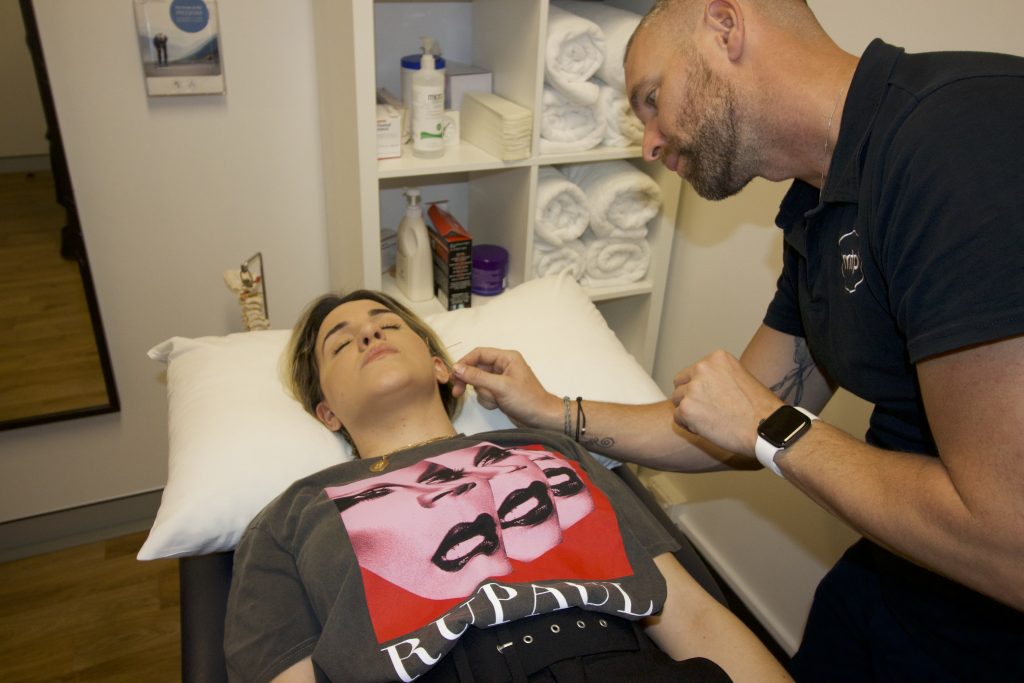
We use a range of proven treatments to help relieve TMJ pain in the early stages
A Conservative Approach
Phase 1: Identify Causes, provide relief, Address biggest Issues
From this initial assessment, our practitioner will have a good idea of the primary contributing factors of the TMJ pain that is being experienced.
Statistics show that conservative management (non-surgical) can alleviate symptoms in 50-90% of cases. This includes things such as addressing lifestyle management, general exercise, postural support, joint mobilisation, muscle energy techniques and acupuncture. These modalities can not only help alleviate direct pain and dysfunction but also secondary symptoms such as headaches and neck pain, while also improving functional tasks such as yawning, eating and breathing.
Providing Relief
The begin this conservative approach, the treating practitioner will first undergo treatment aimed at providing relief. These treatments are short term modalities designed to immediately alleviate symptoms and ease pain. This is where most practitioners will stop when it comes to TMJ treatment and in our opinion, where a lot of treatments fall short. NOTE: These are simply designed to be used temporarily until the root cause can be addressed. It must be stressed that they are not to be relied upon as the only long term solution.
To understand a little bit more about why this is the ideal treatment approach, it is worthwhile reading through our comprehensive guide to the science of pain HERE.
Relief treatments include:
- Moist Heat
- Cold Compress
- Massage
- Softer Diet
- Avoid dental strain
- Oral Appliances
- Targeted Physiotherapy (e.g. Dry Needling, Massage, etc.)
- Cognitive Behaviour Therapy & other psychological techniques (More on this in phase 3)
- Medications (e.g. Muscle relaxants, NSAIDs, etc.)
In phase 1, once relief has been provided it is also a great idea to begin introducing exercise. In phase 2, the exercise that was introduced will take a more structured form.
Phase 2: Address primary Root Cause, Introduce Exercise
Now that phase 1 has been completed & the symptoms of the TMJ Pain have been relieved, it can be easy for a patient to think they have been ‘cured’. What we really want to stress is that this is most likely not the case!
Chances are the cause of your TMJ pain & other associated issues was not a lack of relief modalities, medications, oral appliances & targeted relief mechanisms!!
What is more likely, is that the real cause was one of the key underlying factors listed above that have been shown to cause TMJ pain (such as musculoskeletal health, psychological state, structural change etc.). With this in mind, we then begin to introduce phase 2 to our patient’s in order to address the fundamental root causes of their issue. This is where MTP is unique & offers a treatment approach that won’t be found in many other places.
Treatment MTP Style
Exercise.
It’s the first cab off the rank for just about every issue we treat at MTP. And for good reason. When we look at the research, there is a case for the benefits of exercise in just about every health condition & dysfunction the human body will face. When it comes to TMJ, the evidence for exercise is a little scant, however, we believe this is simply because the research was focused on exercises that target the jaw itself. We instead take an approach that is designed to focus on the whole body, as opposed to just the face itself.
We know that our body thrives on movement, so when our lifestyle is lacking physical exercise that challenges it, pain will start to arise as a response of the brain. This can contribute to TMJ pain, particularly when a lot of the other key causal factors are present.
In general exercise, such as what we teach in our Freedom program is a really positive habit for someone to have in their life, which can make massive changes to their overall health. In our experience, not many people (if any) who lead a healthy lifestyle & exercise regularly suffer from TMJ pain. Most people who are affected by it don’t usually lead the healthiest lifestyles. That’s why a big part of our treatment approach is helping people to be healthier for the rest of their lives. This is generally a big part of our philosophy at MTP Health.
We see this focus on improving someone’s lifestyle being a massive benefit for their overall long term health. Our mission is to improve 1 million people’s lives by improving the way they move because we know that movement is key to having good health. With good health comes a better planet & so everything we do at MTP Health is about helping people learn the skills necessary to be as healthy as they can for their entire lives. Unfortunately, due to the way we live in modern society, our lifestyles don’t always suit what would be optimally healthy for our body. As such health becomes somewhat of a skill that needs to be learnt.
We like to see our duty as teaching people who see us for certain issues (such as TMJ pain) about the things they can do to not only relieve their issue, but also be optimally healthy so they can avoid any issue with their health for the rest of their lives. The issue they came to see us about is then seen as a signal from their body saying that what they’re doing isn’t quite working & they need to change things up. This is what our treatment approach at MTP is all about.
It’s no secret that the general benefits of group exercise, are extremely vast, having the capacity to make a huge difference to someone’s life. That’s why we’ve made group training a big focus of how we operate at MTP.
Education
As we described above there are a number of factors that go into contributing to TMJ. One of the primary group of factors that contributes significantly are known as the Biopsychosocial elements. These factors are essentially the factors that go beyond the mechanical ‘diagnosis’ that is attributed to the specific area of the body in question i.e. TMJ. These factors are a significant contributor to our experience of pain and the issue of TMJ issues.
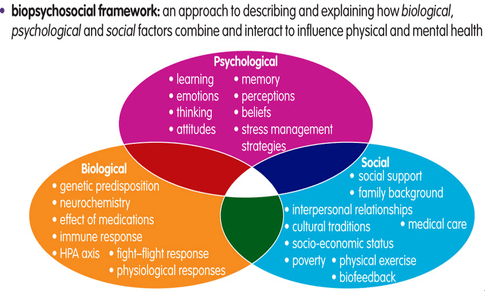
The Biopsychosocial Model and the factors that contribute to pain Pain
The other part of ‘education’ that is often overlooked is the idea of movement education. This is the idea that exercise teaches us how to move in our body & can have significant effects on how we experience pain/ how we feel day to day. On top of this exercise & movement education have been shown to have a litany of benefits for our overall health, as a result of a number of factors.
Phase 3: Lifestyle change & healthy habits
The final piece to the puzzle is allowing people to find a way to incorporate the lifestyle changes they have introduced in phase 1 & 2 in a way that allows them to maintain these new habits for life. This is the only way they can allow their body to continue to adapt & help maintain it’s optimal function for life. See more on this idea in our article on empowerment.
When it comes to issues like TMJ, there is a vastly growing body of evidence that suggests the effectiveness of overall health management. This includes:
- Weight management
- Stress management technique
- Regular exercise programming (Suggestions & recommendations)
If after progressing through these 3 phases after roughly 12 weeks, the patient has not effectively progressed, it would be then indicated for them to revisit their initial referring dentist to consider surgical or other intervention.
